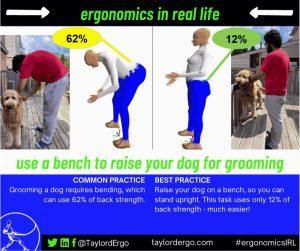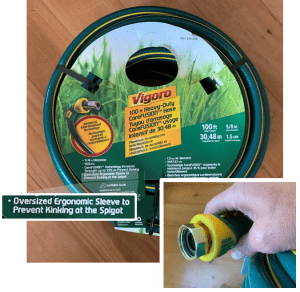Just as a dentist notices a turned incisor, and a mechanic’s ear perks up like a border collie’s at the sound of a bad bearing, ergonomists have trouble shutting down the “ergonomics filter” on their views of the world. In fact, we’ve created a whole series of social media posts about ergonomics “in real life”, and another series entitled “ergonomists on vacation.” We notice how people work, and what has been done (or needs to be done) to make work better. The use of the word “ergonomic” on a package or label triggers a full investigation of the intended benefits. Here are a few of my favourite examples.
Raise the dog to avoid bending

One of our ergonomics interns from Fanshawe College identified that brushing her dog while it was standing on a bench made the brushing task easier. We challenged her to measure how much easier, and she created the summary shown at right. She showed that raising the dog improves lower back demands; most professional groomers already knew this!
SUP demands

The physical demands of stand-up paddleboarding can fascinate my mind for hours. I have a very poor sense of balance, so I haven’t tried to stand on a board since that day back in high school, but I think about it a lot….
- The stance required.
- The balance compensation when paddling on one side, and then the other.
- The force required to pull the paddle back.
- The torso muscles that are used for this activity (and so few others).
- The effect of heat stress, sun exposure, and no access to drinking water if you go too far.
- The strategy (and risk) involved in maneuvering waves and boat wakes.
I’m not planning to try it any time soon, but I do enjoy thinking about it!
My husband bought an “ergonomic hose.”

Did he get “hosed”? He bought the hose to replace one that snapped off at the spigot. The old hose came with the cottage, and we had struggled to attach it to the faucet. One day it just fell apart.
The new hose claims to have an “ergonomic sleeve to prevent kinking.” What, exactly, is “ergonomic” about the sleeve?
- The diameter and surface of the handle meet ergo design guidelines. (check)
- The “sleeve” appears to prevent the hose from bending at the point where the hose attaches to the spigot. It makes sense to me that this might be a common place for breakage, not just because of our recent experience, but also since it is the point where a moving part (the hose) meets a fixed part (the spigot).
- The inside of the sleeve is shaped like a wrench, and the outside of the spigot is shaped like a nut. I can rotate the sleeve and tighten the hose to the spigot. I’ve had trouble securing these two components together, so I do appreciate this feature.
In many cases, ergonomists are appalled at the mis-use of the word “ergonomic”, but in this case, I believe it was used correctly. Well done, Vigoro! (And nice choice, hubby!)
Everywhere we look, ergonomists “see” issues, innovations, and ideas. How does your occupation colour your world?


